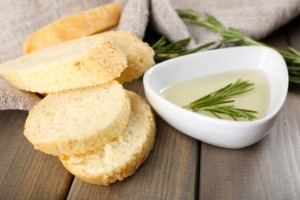As your essential oil collection increases, so does your know-how. You learn which oils are best to use in the morning. You curate a mental list of diffusion blends that change the mood in your home. And you know which essential oils help you find your Zen when added to bathwater. But did you know that many of our oils can be used in the kitchen?
We’ve compiled some of our favorite tips for using essential oils in the kitchen. Add these delicious tips to your repertoire!
Breakfast
 Waffles: Add 1–4 drops of Orange essential oil to wet waffle mix.
Waffles: Add 1–4 drops of Orange essential oil to wet waffle mix.- Oatmeal: Add 1 drop of Cinnamon Bark and 2 drops of Orange essential oil to a bowl of oatmeal or oat bran, and then sweeten with Blue Agave.
- Lemon with Berries: Add Lemon essential oil to berry protein shakes or to plain yogurt and top with berries.
Snacks
- Vegan Cream Cheese Spread: Put vegan cream cheese into a bowl and mix in Cinnamon Bark OR your choice of citrus essential oil to taste.
- Olive Oil: Add various culinary herb essential oils to your olive oil, such as Rosemary. Pour over a plate of balsamic vinegar and use focaccia bread for dipping.
Dinner
- Tomato Pasta Sauce: Add 2 drops of Basil essential oil and 1 drop each of Rosemary and Thyme essential oil to tomato sauce base.
 Potato Salad: Add 1–2 drops of Dill essential oil to potato salad.
Potato Salad: Add 1–2 drops of Dill essential oil to potato salad.- Rice Pilaf: Add 4 drops of Lemon essential oil to water before adding rice.
- Salad and Fruit Rinse: Use 3 drops of Lemon essential oil in a bowl of water when rinsing lettuce, grapes, berries, and greens.
- Chick Pea Salad Sandwiches: Add 2 drops of Lemon essential oil per can of chick peas and mix with vegan mayonnaise, celery, sea salt and freshly ground pepper. Spoon onto whole grain bread and serve topped with alfalfa sprouts.
Beverages
 Hot Lemon Tea: In 1 cup of hot water, mix in 3 drops of Lemon essential oil and Blue Agave to taste.
Hot Lemon Tea: In 1 cup of hot water, mix in 3 drops of Lemon essential oil and Blue Agave to taste.- Horchata with a Twist: Add 1 drop of Cinnamon Bark essential oil to a tall glass filled with ice and vanilla rice milk.
- Vanilla Protein Shake: Add 2 drops of Lemon or Peppermint essential oil to any vanilla protein shake.
- Flavored Water: Add 1 drop of Peppermint essential oil to your gym water bottle.
Get started on your amazing essential oils journey by enrolling as a wholesale member:













